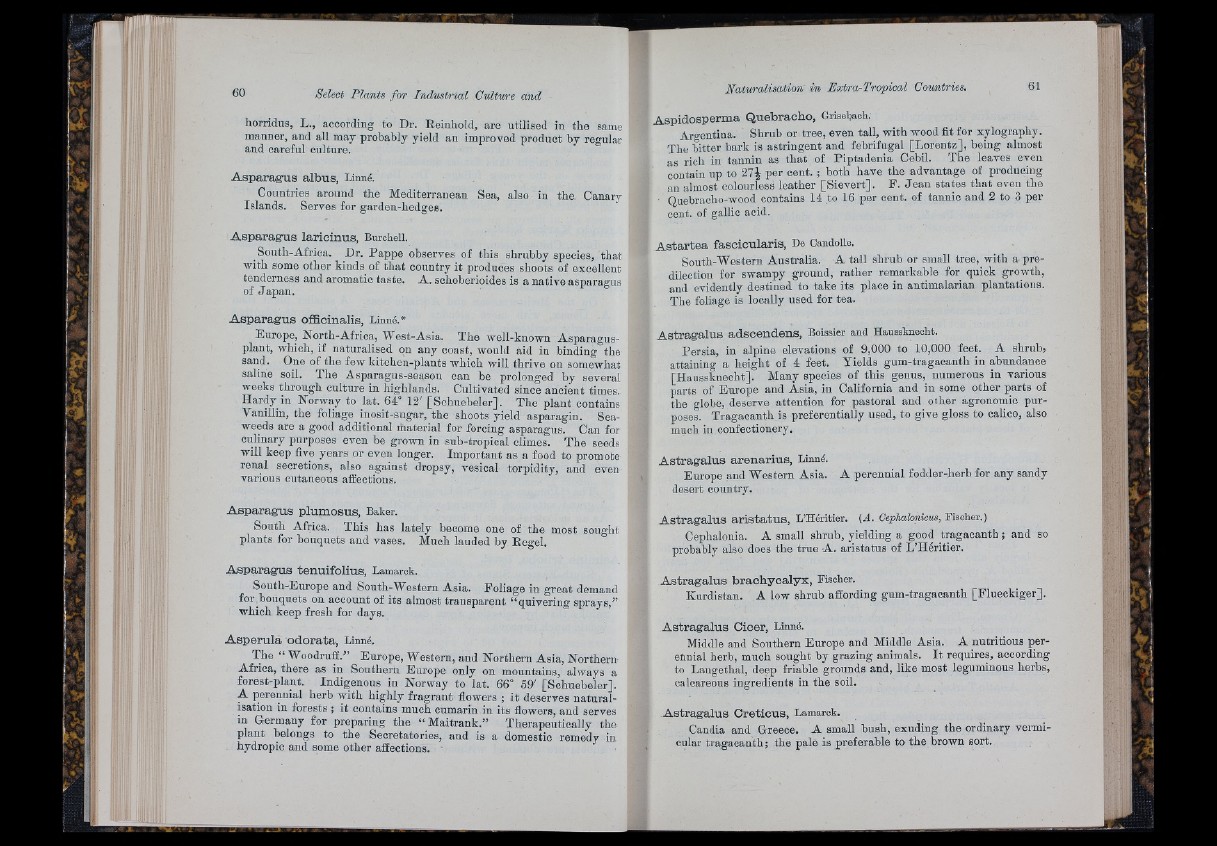
horridiis, L., according to Dr. Reinhold, are utilised in the same
manner, and all may probably yield an improved product by regular
and careful culture.
A s p a r a g u s a lb u s , Linné.
Countries around the Mediterranean Sea, also in the Canary
Islands. Serves for garden-hedgeg.
A s p a r a g u s la r ic in u s , Burohell.
South-Africa. Dr. Pappe observes of this shrubby species, that
with some other kinds of that country it produces shoots of excellent
tenderness and aromatic taste. A. schoberioides is a native asparagus
of Japan.
A s p a r a g u s offlcina lis, Linné.*
Europe, North-Africa, West-Asia. The well-known Asparagus-
plant, which, if naturalised on any coast, would aid in binding the
sand. One of the few kitchen-plauts which will thrive on somewhat
saline soil. The Asparagus-season can be prolonged by several
weeks through culture in highlands. Cultivated since ancient times.
Hardy in Norway to lat. 64“ 12' [Schuebeler]. The plant contains
Vanillin, the foliage inosit-sugar, the shoots yield asparagin. Seaweeds
are a good additional material for forcing asparagus. Can for
culinary purposes even be grown in sub-tropical climes. The seeds
will keep five years or even longer. Important as a food to promote
renal secretions, also against dropsy, vesical torpidity, and even
various cutaneous affections.
A s p a r a g u s p lum o su s . Baker.
South Africa. This has lately become one of the most sought
plants for bouquets and vases. Much lauded by Regel.
A s p a r a g u s te n u ifo liu s , Lamarck.
South-Europe aud South-Western Asia. Foliage in great demand
for bouquets on account of its almost transparent “ quivering sprays,”
which keep fresh for days.
A s p e ru la o d o r a ta , Linné.
The “ Woodruff.-” Europe, Western, and Northern Asia, Northern
Africa, there as in Southern Europe only on mountains, always a
forest-plant. Indigenous in Norway to lat. 66° 59' [Schuebeler].
A perennial herb with highly fragrant flowers ; it deserves n a tu ra lisation
in forests ; it contains much cumarin in its flowers, and serves
in Germany for preparing the “ Maitrank.” Therapeutically the
plant belongs to the Secretatories, and is a domestic remedy in
hydropic and some other affections.
A sp id o sp e rm a Q u e b ra c h o , Griseljach.
Argentina. Shrub or tree, even tall, with wood fit for xylography.
The bitter bark is astringent aud febrifugal [Lorentz], being almost
as rich in tannin as that of Piptadenia Cebil. The leaves even
contain up to 27^ per cent. ; both have the advantage of producing
an almost colourless leather [Sievert], F. Je an states th a t even the
Quebracho-wood contains 14 to 16 per cent, of tannic and 2 to 3 per
cent, of gallic acid.
A s ta r te a fa s c ic u la ris , De Candolle.
South-Western Australia. A tall shrub or small tree, with a predilection
for swampy ground, rather remarkable for quick growth,
and evidently destined to take its place in antimalarian plantations.
The foliage is locally used for tea.
A s tr a g a lu s a d s c e n d e n s , Boissier and Haussknecht.
Persia, in alpine elevations of 9,000 to 10,000 feet. A shrub)
attaining a height of 4 feet. Yields gum-tragacanth in abundance
[Haussknecht]. Many species of this genus, numerous in various
parts of Europe and Asia, in California and in some other parts of
the globe, deserve attention for pastoral and other agronomic purposes.
Tragacanth is preferentially used, to give gloss to calico, also
much in confectionery.
A s tr a g a lu s a r e n a r iu s , Linné.
Europe and W’estern Asia. A perennial fodder-herb for any sandy
desert country.
A s tr a g a lu s a r i s ta tu s , L’Héritier. (A. Cephalonicua, Fischer.)
Cephalonia. A small shrub, yielding a good trag a c an th ; and so
probably also does the true A. aristatus of L ’Héritier.
A s tr a g a lu s b ra c b y c a ly x , Fischer.
Kurdistan. A low shrub affording gum-tragacanth [Flueckiger].
A s tr a g a lu s Cicer, Linné.
Middle and Southern Europe and Middle Asia. A nutritious perennial
herb, much sought by grazing animals. I t requires, according
to Langethal, deep friable grounds and, like most leguminous herbs,
calcareous ingredients in the soil.
A s tr a g a lu s C re tio u s , Lamarck.
Candía and Greece. A small hush, exuding the ordinary vermicular
tragacanth; the pale is preferable to the brown sort.